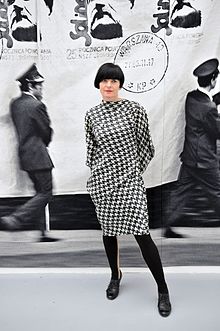Polish artist Goshka Macuga’s tapestry at the Kochi-Muziris Biennale hangs from the top and spreads into the walking area, inviting the viewer to partake in the artist’s call for unification of women.
Titled ‘Death of Marxism, Women of All Lands Unite’, which is on view at the art festival’s main venue of Aspinwall House, the hall-size exhibit shows an image of Karl Marx’s tomb in London that has been transported into a local setting, which has women from Kerala surrounding the famous landmark.
Speaking about the theme of gender inequality and Marxism in her work, Goshka, 52, says, “Taking its title from the communist motto ‘Workers of all Lands Unite’ which is engraved on Marx’s tombstone in London, the work staged a shift from a communist call to action to end class struggle to a feminist empowerment against sexist oppression.”

In Kochi, the work still addresses the same issues, according to the artist, but the context is very different with Kerala still being a strong communist state where the communist ideology is not a subject of the past.
Known for her research-based work, the artist originally created the exhibit in 2013, which was partially inspired by the works of Miroslav Tichý, the famous Czech artist who voyeuristically photographed women in the streets and parks of his hometown.
For the purpose of the biennale, the tapestry, that functions both as a wall hanging as well as a carpet on the floor, was redone to reflect local topography and culture.

“The original leafy setting for a group of women having a picnic is replaced in Kochi Biennale by an image of the local setting and the group of women from Kerala surrounding Marx’s tomb. Some of the original figures from photographs by Tichý are also included in the image,” said Goshka, who lives and works in London.
An important aspect of her work, the artist adds, is the physical inclusion of the dimension of depth, through which the artist opens up a space by inviting the visitor to enter the work and become part of the image. This is also made possible through a selection of books, about Kerala’s communist and feminist history, that the viewer can browse through while sitting on the artwork.
Some of the well-known titles which are available at Goshka’s presentation include: “Revolutionary Desires: Women, Communism and Feminism in India”, “Her-self: Gender and Early Writings of Malayalee Women”, and “Hangwoman”.

Goshka, whose art practice involves a wide range of materials and mediums, has focused on the subject of women and their representation in her previous work as well. From Madame Blavatsky, the Russian aristocrat who founded the Theosophical Society, to iconic women from the world war generations, the artist’s repertoire has encompassed many facets of history, with her recent focus being women’s rights and #MeToo.

Featured image: View of Goshka Macuga’s work at Aspinwall House, Fort Kochi; courtesy of Kochi Biennale Foundation